Se siete frustrati dall’impossibilità di cambiare il vostro nome utente di WordPress, non siete i soli.
Ci siamo imbattuti in questo problema durante la creazione di nuovi siti e sappiamo che può essere un vero mal di testa. La buona notizia è che, anche se non è così semplice come ci si potrebbe aspettare, ci sono sicuramente dei modi per cambiare il nome utente di accesso.
In questa guida vi illustreremo 3 metodi collaudati per cambiare il nome utente di WordPress, in modo che possiate finalmente sbarazzarvi del vecchio nome utente e ricominciare da capo.
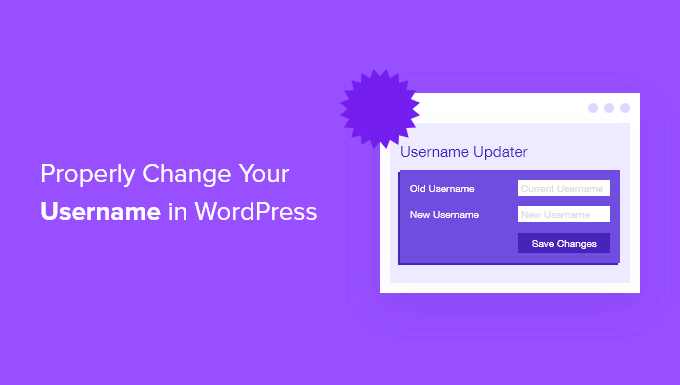
È possibile modificare i nomi utente di WordPress?
I nomi utente non possono essere modificati in WordPress. Questo messaggio viene visualizzato quando si modifica il proprio profilo WordPress o si modifica il proprio nome completo.
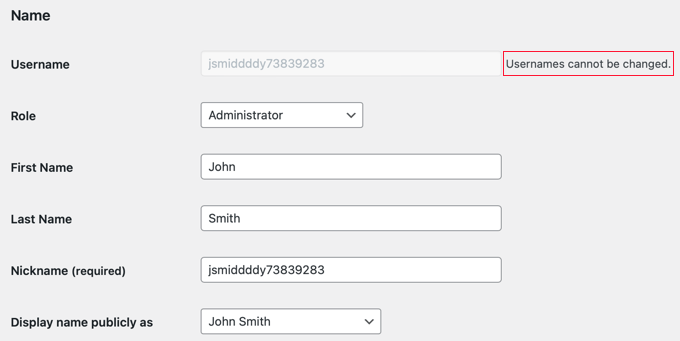
Questo può essere frustrante e confondere gli utenti di WordPress alle prime armi. La buona notizia è che esistono diverse soluzioni per cambiare il nome utente di WordPress.
Questo articolo vi mostrerà tre modi per modificare un nome utente sul vostro sito web WordPress. Potete utilizzare i link sottostanti per passare al metodo che desiderate utilizzare:
Metodo 1: Creare un nuovo utente ed eliminare quello vecchio (senza plugin)
Il modo più semplice per cambiare il nome utente di WordPress è creare un nuovo utente con il nome utente desiderato e con il ruolo di amministratore.
L’unico inconveniente è che dovrete utilizzare un indirizzo email diverso da quello utilizzato dal vostro account attuale.
Nota: se si utilizza Gmail, è possibile inserire un segno più (+) con lettere aggiuntive dopo il nome utente.
Ad esempio, se il proprio indirizzo email è myname@gmail.com, è possibile utilizzare l’indirizzo email myname+wordpress@gmail.com. Verrà comunque inviato alla stessa casella di posta elettronica, ma WordPress lo considererà un indirizzo email separato.

Dopo aver creato il nuovo account, è necessario disconnettersi dal proprio account WordPress e poi accedervi con il nuovo account utente appena creato.
Quindi, andate alla pagina Utenti ” Tutti gli utenti nell’area di amministrazione di WordPress e fate clic sul collega “Elimina” sotto il vecchio nome utente per rimuoverlo.

Quando si elimina il vecchio nome utente, WordPress chiederà cosa si vuole fare con tutti i contenuti creati da quell’utente.
Fare clic sull’opzione “Attribuisci tutti i contenuti a” e selezionare il nuovo utente appena creato.

Dopodiché, fai clic sul pulsante “Conferma eliminazione” per eliminare il vecchio account utente.
Congratulazioni, avete cambiato con successo il vostro nome utente di WordPress. Se volete usare lo stesso indirizzo email di prima, potete ora cambiare l’indirizzo email del nuovo utente.
Metodo 2: Usare un nome utente facile da aggiornare (metodo del plugin)
Un altro modo semplice per cambiare il nome utente di WordPress è utilizzare un plugin. Se siete preoccupati di utilizzare troppi plugin di WordPress, vi assicuriamo che potete tranquillamente eliminare il plugin una volta modificato il nome utente di WordPress.
La prima cosa da fare è installare e attivare il plugin Easy Username Updater. Per maggiori dettagli, consultate la nostra guida passo-passo su come installare un plugin di WordPress.
Dopo l’attivazione, è sufficiente andare alla pagina Utenti ” Aggiornamento nomi utente e fare clic sul collega ‘aggiorna’ accanto al nome utente che si desidera modificare.

A questo punto, è sufficiente inserire il nuovo nome utente e fare clic sul pulsante “Aggiorna nome utente”.
Se si desidera notificare all’utente la modifica, assicurarsi di aver selezionato prima la casella “Invia notifica all’utente”.
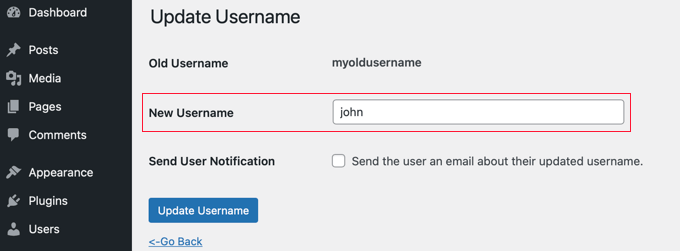
Tutto-in-uno! Ora è possibile rimuovere il plugin per il cambio di nome utente dal sito.
Metodo 3: Modificare il nome utente di WordPress con phpMyAdmin (avanzato)
Questo metodo è un po’ complicato perché richiede di apportare modifiche dirette al database di WordPress.
Raccomandiamo agli utenti di evitare di farlo, se possibile, perché è facile sbagliare e causare errori sul sito WordPress.
Tuttavia, in alcuni casi, potreste non avere un’opzione, come nel caso in cui dimentichiate il nome utente e l’indirizzo email di WordPress e veniate bloccati dal vostro account di amministratore.
Per prima cosa, è necessario accedere alla propria Bacheca per individuare il menu phpMyAdmin.
In questo esempio utilizziamo Bluehost. La vostra Bacheca potrebbe avere un aspetto diverso se ospitate un altro host che non utilizza cPanel, ma l’opzione phpMyAdmin dovrebbe essere comunque disponibile.
Una volta entrati nella Bacheca di Bluehost, procedere con la navigazione nella scheda “Siti web”. Quindi, selezionare un sito web e fare clic sul pulsante “Impostazioni”.
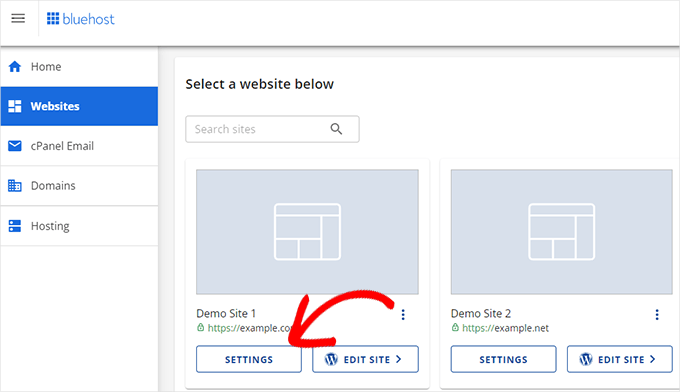
A questo punto, scorrere verso il basso fino alla sezione Collegamenti rapidi.
Dopodiché, fate clic su “phpMyAdmin”.
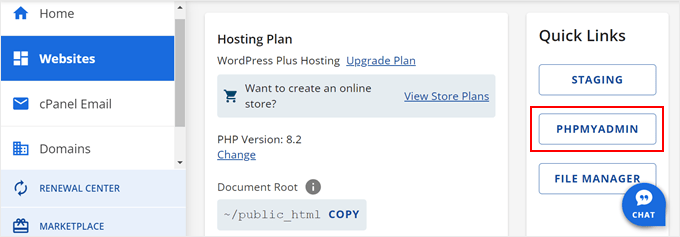
In questo modo si avvierà phpMyAdmin in una nuova scheda del browser.
È necessario selezionare il database di WordPress, se non è già stato selezionato.
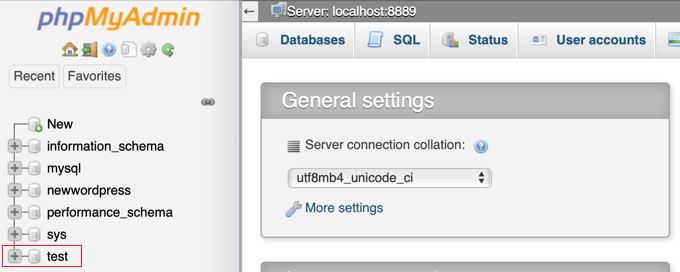
Ora si vedranno le tabelle del database di WordPress. Di default, le tabelle del database di WordPress utilizzano wp_ come prefisso prima del nome di ogni tabella. È possibile che abbiate cambiato il prefisso del database in un altro.
È necessario fare clic sulla tabella wp_users sul lato sinistro. Poi, si deve fare clic su “Modifica” accanto al nome utente che si desidera modificare.

A questo punto, si potrà digitare il nuovo nome utente che si desidera utilizzare nel campo user_login.
Una volta terminato, dovrete fare clic sul pulsante “Vai” in fondo allo schermo per salvare il nuovo nome utente.

Tutto-in-uno! Ora dovreste essere in grado di accedere alla vostra Bacheca con il nuovo nome utente.
Approfondisci i modi per gestire gli utenti di WordPress
Volete altri suggerimenti e trucchi per gestire gli account utente di WordPress? Ecco altri articoli che potete leggere per iniziare:
- Come modificare la password in WordPress (Guida per principianti)
- Come forzare le password forti sugli utenti in WordPress
- Come disconnettere automaticamente gli utenti inattivi in WordPress
- Come aggiungere o rimuovere capacità ai ruoli degli utenti in WordPress
- Come bloccare un utente di WordPress senza eliminare il suo account
- Come salutare ciascun utente con un messaggio di benvenuto personalizzato in WordPress
- Come aggiungere ulteriori campi per il profilo dell’utente nella registrazione di WordPress
- I migliori plugin per il registro delle attività e il tracciamento di WordPress (a confronto)
Speriamo che questo tutorial vi abbia aiutato a capire come cambiare correttamente il nome utente di WordPress. Vi consigliamo anche di consultare il nostro tutorial su come passare istantaneamente da un account utente all’altro di WordPress e la nostra selezione dei migliori plugin per gestire un blog WordPress multi-autore.
Se questo articolo vi è piaciuto, iscrivetevi al nostro canale YouTube per le esercitazioni video su WordPress. Potete trovarci anche su Twitter e Facebook.





Val
I used the first method and I am unable to delete the other user. Has anyone run into this issue? Now that I have another user with the username I actually want I am concerned that I can’t move on to method 2 or 3 because the username is already in use.
Sarah Sullivan
Hi, My site is still under construction, when I was setting it up I followed the steps I had printed out instead of listening to the audio too. I only realised afterwards that I shouldn’t have used my real email address as the username as this will be visible once I start posting. Which method above would you recommend I follow to make the necessary change as I haven’t yet got any content to worry about losing?
The other thing I keep getting really confused about is when I am asked for my email address do they mean my real one or the one that is part of website that I would like to handle?
Thanks
Sarah
WPBeginner Support
Sarah you can add as many users account to your WordPress site as you want. Simply go to the Users page in admin area and then click on add new. You can add users with different roles like administrator (site owner), editor, author, etc. If you are the only one using your site, then a user with administrator role is all you need. After you have created a user name that you like, feel free to delete the old one that you do not wish to use anymore.
The email address they ask will be used to send you notification emails. It has to be any existing email address that you already use.
WordPress itself is not an email client and it will not create an email address as part of your website. If you want to have a branded email address with your own domain name like sarah@example.com, then see our guide on how to setup a professional email address with Google Apps and Gmail
Admin
iulian
Great tip. Thank you!
Niaz Khan
Thank you, admin, after reading your blog I have successfully changed the usernames of my blog bestcmsplugins.com ,
You are doing a great job by helping others
Kellie Grace
This was so quick and simple! Thank you so much!
Julio Falconi
I did it and when i went on my new account it doesn’t show users tab or any other tabs
Angel A.
Thank you so much! The first method worked flawlessly.
Alan Cox
At last someone who really makes it easy. Well done and thank you.
Danstan
Thanks
ERic
Thank you. The Plugin worked perfectly
Vijay
Thank you so much for this article. I took the phpMyAdmin route and it worked… But, before it started working it did this weird thing where if I entered the url of the user’s profile it took me to the home page.
But then in the end it worked. Probably because I saved the profile from wp-admin after having changed the user_login and the user_nicename values from phpMyAdmin?
Daniel Taylor
That’s for the great advice. The plugin was the most easiest way.
madivad
Too many places to reply so I’ll create a new comment.
I’m one of those people that don’t like to just add another plugin (even if I can remove it afterwards) and so even after reading about the create new user/delete user/migrate posts method, I liked the phpmyadmin method.
But it does cripple multisite installs and you really should update the main post about that.
For anyone who does do it the database way, you have to go into your sitemeta table and update the superadmin user with the new username and character count in the S:flag.
Otherwise, the create/delete/migrate method might actually be a better option
Cassy
Here is the way I did it – very quick and easy, took me less than 5 minutes to do:
1. Go to users
2. Click on the user name you want to change
3. Above the “Update Profile” button, there will be text that reads “Were you looking for your API Key and other Personal Settings”. The ‘API Key and other Personal Settings’ text will be highlighted (as it is a link).
4. Click on this highlighted text.
5. Scrolls down the page to the heading “Account Details”
6. Just under “Account Details” will be ‘User Name’
7. You will see next to your user name there will be the word ‘Change’ in brackets, also in highlighted text (indicating it is a link).
8. Click on this text to change your user name.
9. Don’t forget to save
10. You can change all other linked settings from here, such as BLOG NAME, PRIMARY BLOG, etc,
Traci
Hello,
Thanks for the article! Out of curiosity, would a change of my WP login username prompt a DISCONNECT to wordpress.com jetpack stats and tools?
I’m asking b/c today, I changed it (due to tireless notifications of site lockout attempts from….who knows?), and now my jetpack stats are all screwy and wordpress.com no longer recognizes my website. I’m getting this error message:
unknown_token: It looks like your Jetpack connection is broken. Try disconnecting from WordPress.com then reconnecting.
But no further instructions on what to do. Love to know your thoughts.
Thanks! LOVE your all of your content!
Chris
A word to the wise, from someone who wasn’t. Using that plugin can be fatal to a multisite setup. Multisite does not allow the user name of the superadmin to be changed. And there is no warning about this on the plugin site. But because the plugin just twiddles with the name fields of the database it gaily ignores this. So if you use it, be prepared to lose all access to the network. This might not happen if the name you change it to happens to have the same number of characters as the name you are changing from. I am not about to prove this point though, once bitten and all that. The remedy is then only direct editing of the database to restore precisely, and I do mean precisely including cap and lower case usage, what was there before.
Miha
Hi,
i successfully changed username on the multisite installation.
I have changed username directly in sql database.
First of all backup your db.
You have to change username in tables:
_users in fields: user_login and user_nicename
_usermetadata field nickname and
_sitemeta field site_admins
in the field site_admins be careful to change the name admin and number of letters before admin in variable s:5
admin username has 5 letters, change it to number of letter in your new name
Delete cookies in browser, login again to your WP admin and you have network access with your new username
Frank
Does it make sense to change the user ID as well?
Bob The Builder
Here is something odd that I’ve noticed today.
I did not like it that my (admin) username was visible in the author URL. So I decided to create a new user with author role and since I’ve made this new user the author URLs are the same as the screennames.
So now I can use my admin account again since the screenname is visible in the URLs and not my actual username.
Any explanation for this?
WPBeginner Support
WordPress uses the username in the Author URLs. If the admin user still has posts then their author URL will still appear on those posts. You can assign those posts to new author account you created and set a redirect for the admin url.
Admin
Paul Okeke
Everything about WPbeginner.com is awesome. This article and all I have come across from the same source worked for me. Just want to say a big thanks to wpbeginner.com editorial saff. Cheers!
Adriana
Would the process “Create a New User and Delete The Old One” work properly from network admin area on a multisite installation?
Muhammad
It worked! Many thanks!
MattFromGA
This change may or may not be a big problem for a given wordpress site based on the plugins and theme it is using. What if there is a plugin that uses an external system that associates data with username? The simple change outlined here would fail to update that username in the external system and the association between the user and that external data would be broken with this change. What about forum posts in bbpress where a user mentions another user by username?
I guess a basic wordpress blog install wouldn’t have too many problems with this, but beyond that you better have awareness of the other plugins and theme dependencies on username. If none, this simple change could be fine.
Rose
Yes And we’ve seen this week where this all can lead to. Patching up plugins, fixing holes, hoping the theme has no holes, then after seeing the notorious scammers all have the name, changing username etc. But luckily we can change the name. There’s no other option when all is leaked out. Yes security. Having a good security plugin. Securi I found too difficult to understand. Anyway, there are certainly more problems to fix soon.. boy oh boy.
Braham Dutt Sharma
Hi, I want change my existing blog authority in another login id example: i make 5 blog with my own id and now i want change 1 blog login and password with another email is , can this possible , if possible please help.
Tyler
There is nowhere else it needs to change. Everything is attributed to the ID of the user, not the username. It’s just a text field like email, first_name etc.
MattFromGA
So you have a certainty that ever plugin and theme written for wordpress follows that guidance? What about plugins that share username with external systems which make data associates with that?
Morphine Child
Wow, did phpmyadmin solution… literally 3 seconds of work…
Big thank you!
adeem jan
Yet another informative tutorial from you
Let me tell you honestly, I am totally the non-techie so I had NO idea about how to change the admin username till some time back – nor do I visit the C-Panel – I fear those places…lol…
My friend takes care of the tech aspects, though I’ve learnt it all now and thanks to you all of you tech bloggers sharing your posts here, I keep learning each day!
Yes, for security reasons, you need to change the usernames, more so with the number of cases of hackers all over the web. Better to be safe than sorry later.
Thanks for sharing.…. keep up the good work…
Jatin Chhabra
Well the 1st ine didn’t work but the 2nd one did…
Aaron Dear
Stijn’s way is my favorite way. Haha
Nasir Uddin
Thanks. I knew it before. Another process is given by Stijn Vogels. I do that sometimes. But phpmyadmin process is much easier if you have cpanel details.
Mihaela
Worked for me. Thank you.
vaibhav singh
Hey,
Thanks for taking time to write this. I was thinking it is impossible to change….Thanks a lot
hoa sen vang
That’s good idea, thanks i think found the right way to change user name any more, which make me crazy time.
getnet asfaw
how can i change user name from the hosted website if i can’t access the database of all the users?
Milan
Thanks
BTW
why not choose desired name that appear for that username
Vince Comfort
You make work easier for hackers. Because when hackers want to access your site, they start with the desired, sitename and initials.
Jitendra Vaswani
Thnxxx for this amazing article. I was eager to change my username. finally i got solution.
Kamal G
Very Very Useful Thanks a lot for sharing,it saved lot of time…
Dave OSullivan
Thanks, worked a treat. Instead of ‘Usernames cannot be changed’ why doesn’t it say ‘Usernames can only be changed in your hosting cPanel’ Thanks fir the tutorial
Michael Bryant
Awesome tutorial, thanks for the info. Worked just like the steps you outlined. Thanks.
John G.
That really helped out, thanks for posting it. Really was one, two, and done.
Richard
I have installed probably three wp site recently and my email address is being put in as user id. When I try to change by creating a new admin and delete the old, the system will not complete the action. So now I have two admins in each install.
Phillip Taare
thanks very cool, I used better Wp security plugin but I did like your article. Cheers
William Patton
wow… how many people don’t update their username on creation? lol
And changing the record in the database without following the chain of records that the original input created is just… wrong. I wouldn’t be giving anyone this advice without a disclaimer. At least it says the easiest way (it should be the recommended way) is to create a new user and attribute all posts to it then make sure that the old user ID isn’t being called from anywhere, if it is update it.
Tyler
What is this “chain of records” you speak about? Every post is attributed to the ID of the user, so changing the username is perfectly safe. It’s nothing more than a field like email, first_name, etc. If you don’t know anything about how WordPress or databases work, it’s probably best not to give advice on it.
Justin
This was extremely helpful. Thanks for making things easy.
Jim White
Worked for me. Thank you.
Chris
Worked for me thanks!
Adnan Gujjar
thanks for this nice trick, i have changed my username
Lilou
I’m French and not English very well. But I wanted to thank you for your help, because I was looking how to change the ID of my WordPress site.
Thank you again.
I put your site in my favorites.
See you soon.
Naveen
thanks a lot
it worked well for me….
wisekal
@Stijn Vogels Changing the username in this manner can also cause other problems. As you mentioned, a person can create a new account, give it admin rights and proceed by deleting the old admin. However, there are in many instances where the admin ID was used for something. When you create a new admin, you create a new ID. By updating the username via “phpMyAdmin” you’re avoiding that being changed.
@kovshenin This is 100% correct and goes with what I said above. In my opinion the best approach is that which was recommended above in this article. It keeps a lot of the crucial information you may require rather than loosing it when creating a new admin user.
Additionally to all this, you can also download a plugin or two by Website Defender, one being “WP Security Scan” and the other “WP Secure”. These plugins allow for you to seamlessly update your database username and prefix used by your installation without any access required to the databases. Two plugins I strongly recommend for various reasons.
– Bryce Wisekal
kovshenin
@wisekal Hi Bryce! Sorry but you’re wrong, messing with the wp_users table directly is in fact insecure, because of the various actions and filters run during functions like wp_insert_user and wp_update_user including cache revalidation, data sanitization and much more. When updating your table directly you’re short-circuiting all those actions and filters, so plugins, themes and core that rely on them will simply fail. An example of such a plugin is any persistent object caching plugin that uses wp_cache_get.
kovshenin
Stijn’s right, it’s easier and requires no messy phpMyAdmin routines, to just create a new user and then attribute all posts. However, it’s worth noting that usernames are used in the permalink structure for author archives, like your archives are now on /author/wpbeginner/ and if you changed your username, all those previous links will turn into 404 errors.
~ Konstantin
Stijn Vogels
@kovshenin Methinks an archive for /author/kovshenin/ would be more relevant than /author/admin/ which will probably generate a million results… According to Google, about 17,3 million. No argument that your procedure is the most valid, but it should be done from the beginning.
kovshenin
@Stijn Vogels I’m not saying it’s good or bad, wrong or right, worth the trouble or not. I’m just saying what will happen to your previous author archives, so nobody is surprised
Editorial Staff
Not sure if I understand you correctly Konstantin.. But in my experience, the old URLs stay the same. For example if the URL is /author/wpbeginner/ << it will continue to work. For example if I changed the username to newname... the url /author/newname/ won't work. But that has no impact on anything. As a matter of fact some may even say that this is good for security because now the hackers don't know your username.
Admin
GWW
I believe the URLs use the user_nicename field. By default, this is set to the user_login field after being passed through `sanitize_title` (which replaces accented characters, removes HTML and PHP tags). If you update user_login without changing user_nicename, URLs remain unaffected. If you update both fields, URLs will change; any URL using the old nice name will result in a 404.
whereskarlo
This. What about if you only change the nicename but leave the username intact? I’d rather keep my username and make the urls prettier.
Stijn Vogels
Even easier:
1. Create a new admin profile for yourself, with the name you want.
2. Delete you old admin profile and transfer all posts to the new account.
3. Done.
Mohit Bumb
@Stijn Vogels lol nice
charmain
Nice one!! Thanks a……gazillion! Very helpful!
Nasir Uddin
That takes more time than phpmyadmin process.
Alex Schenker
Yes, but just barely. And I’m guessing the phpmyadmin process doesn’t update the username everywhere it needs to change – which could break something down the road.
Will
This is so cool! Thanks a lot Was wondering how to do this.
Was wondering how to do this.